Net-Zero Hero: Andrew Cortes
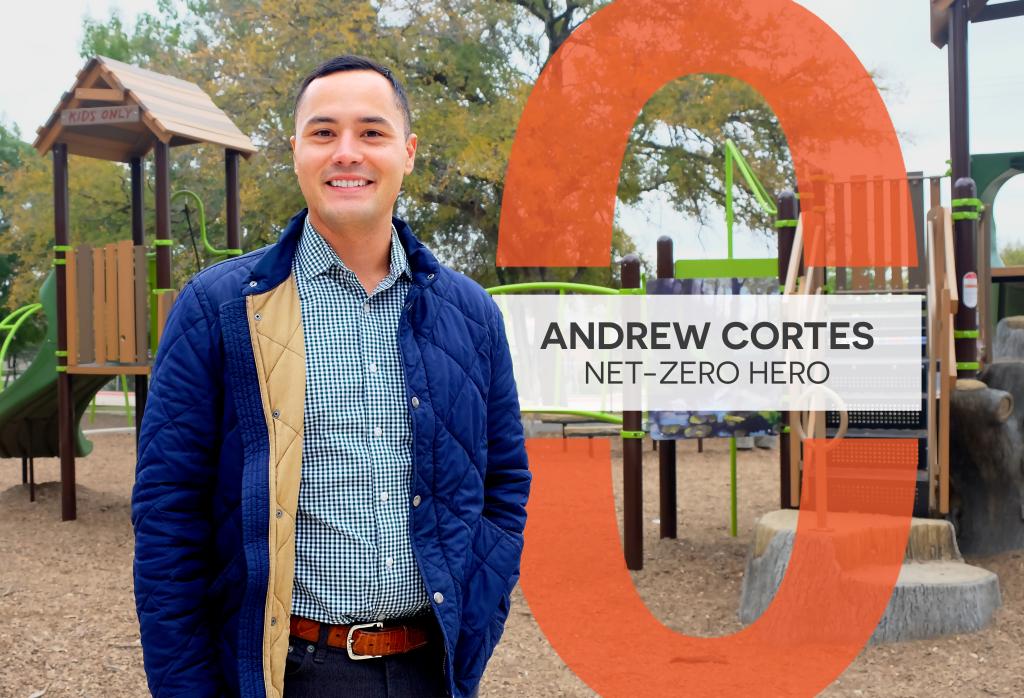
I’m helping to make Austin Net-Zero by supporting Austin’s urban parks reforestation efforts.
Andrew Cortes saw a need for shade in his local park — and stepped up to address it. Partnering with the City of Austin’s Parks and Recreation Department and the Highland Neighborhood Association, Andrew worked to secure funding through the Austin Parks Foundation and the Office of Sustainability’s Bright Green Future Grants Program to plant native trees in the T.A. Brown School Park and, for that, is being named our newest Net-Zero Hero.
We met with Andrew after a recent Parks and Recreation Department’s planting day at the T.A. Brown School Park to talk about reforestation, what it means to him to include his kids in his efforts, and project management advice he would share with others.
What inspired you to take action?
My family and I spend quite a bit of time at the T.A. Brown School Park. A lack of shade in the park made it less enjoyable than it could be, especially during hot Texas summers, so I decided to plant a few trees. I hoped that one day, they would enhance the overall quality of life for people using the park.
As a parent, I also saw an opportunity to teach my kids about the importance of environmental stewardship, hard work, and giving back to the community. With this in mind, I involved them in planting, mulching, watering, and caring for the trees until they were established.
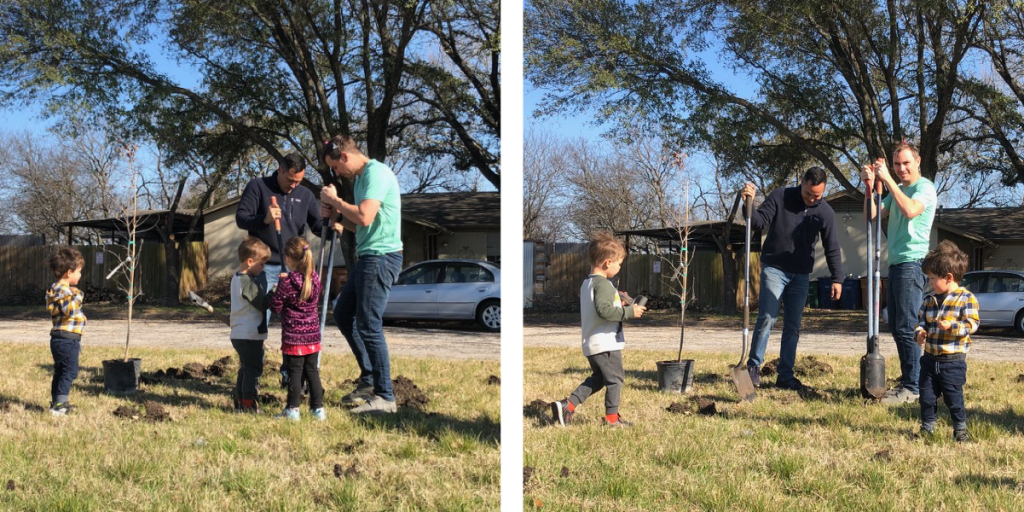
The Cortes family and neighbors pitch in at a tree planting.
Our neighbors and the T.A. Brown Elementary School community were very thankful and supportive of the project, but the overall lack of tree coverage in the park was still a concern. I decided to look into grant opportunities for a more robust reforestation of the park.
How did you do it?
It started with a single red oak tree. I purchased the tree at a local nursery and planted it on a part of the school grounds that I could reach with the hose from my house. When I found out about TreeFolks’ tree adoption program, I would go to their events and adopt trees to plant in this same area. My kids and I joined with some of our neighbors to plant the trees and would come out regularly to water them.
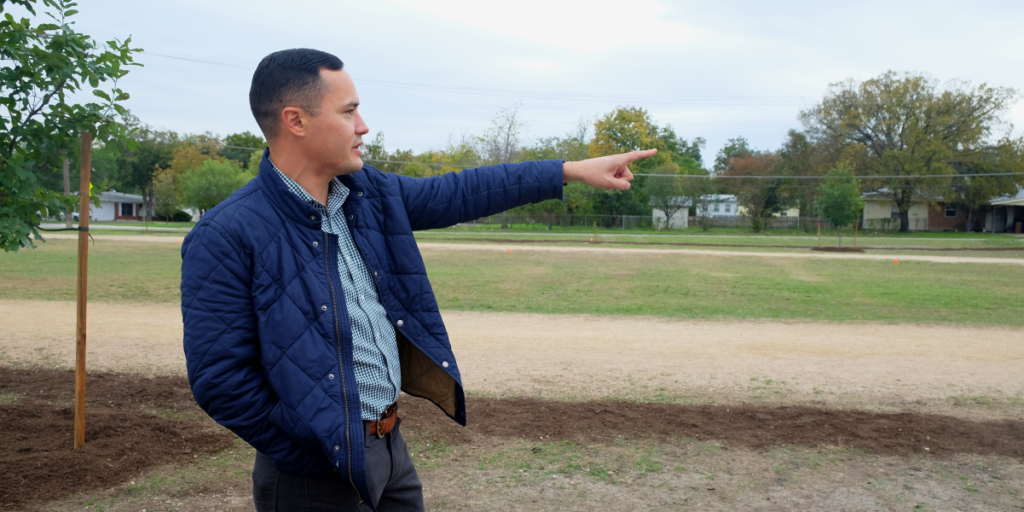
Andrew points out the initial area he focused on, based on where the hose from his house could reach.
As the idea expanded, I started by researching the City’s planning priorities and discovered that the T.A. Brown School Park is located in a high-priority area for reforestation according to the City of Austin’s Urban Forest Plan. Collaboration with the community was crucial for its success, so I reached out to neighbors and T.A. Brown School Park to gauge interest and gather support for a Community Activated Parks Project.
Once I received approval for the Park Plan, I engaged with non-profit partners like TreeFolks to plant additional trees each planting season and began applying for funding resources like the Bright Green Future Grants Program and the Austin Parks Foundation’s Community Impact Grants.
Through these programs and efforts, I was able to pass along a “shovel-ready” project with funding to the Austin Parks and Recreation Department for execution. The neighborhood is very excited about the diverse mixture of native shade and ornamental trees the Parks and Recreation Department planted along the park’s perimeter this fall.
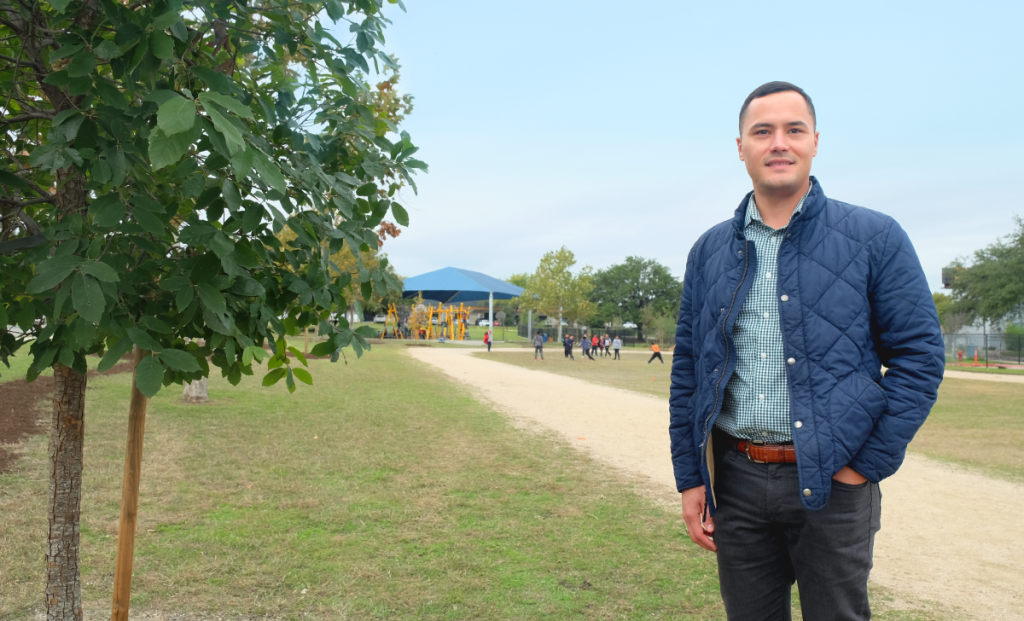
Andrew stands near a tree recently planted by PARD as students play behind him.
What’s been most rewarding about getting involved in this way?
The most rewarding aspect of getting involved in this project has been witnessing the growth of the trees and how they positively impact the community. I planted small trees five years ago that were about 4- or 5-feet tall. I always thought about how long it would be before I was able to enjoy significant shade from them, but I recently saw a neighbor park a baby stroller beneath what is now a 12-foot tall tree, which reminds me of a quote by Nelson Henderson: “The true meaning of life is to plant trees under whose shade you do not expect to sit.”
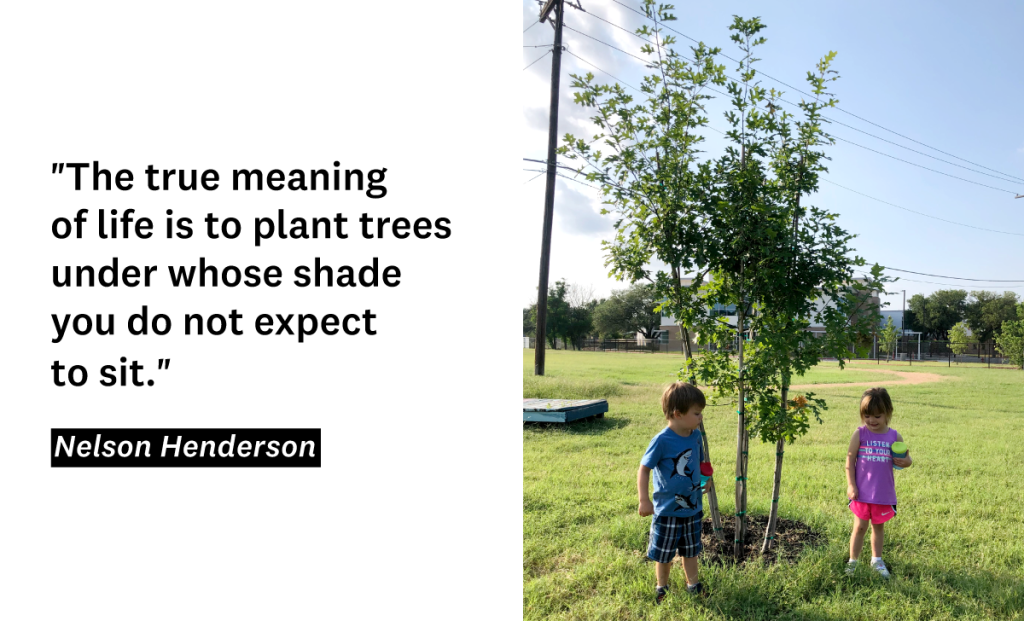
Moreover, involving my kids in this urban tree planting project has been a gratifying experience that I hope will lead to an appreciation for outdoor play, urban parks, and promoting balance within a built environment.
What’s been the toughest part?
Apart from the time and effort associated with maintaining the trees until they are established, the toughest part of the project may have been navigating the processes and approvals needed to execute a project like this and securing a long-term watering solution. However, the support from City staff and the community, and the sense of accomplishment, made it all worthwhile.

Andrew’s twins took turns watering the newly planted trees during the hot summer months.
Your work at T.A. Brown was funded in part through a Bright Green Future Grant. What inspired you to apply for the grant, and how was the process?
I came across the Bright Green Future Grants (BGFG) Program on the City’s website and learned it is intended to support environmental projects that inspire students to become lifelong environmental stewards and improve the learning environment. Since T.A. Brown School Park is a facility used by the Austin Independent School District and much of the proposed scope met the criteria for the grant, I thought it would be a good opportunity for the Highland Neighborhood Association to collaborate with Austin ISD and the Parks and Recreation Department to achieve a common goal. I found that there was a lot of overlap in the grant applications for the Bright Green Future Grants program and the Austin Parks Foundation grants I had been applying for. They share common goals, so I provided a copy of the reforestation plan to T.A. Brown administration along with BGFG application materials so that they could apply to support additional tree plantings.
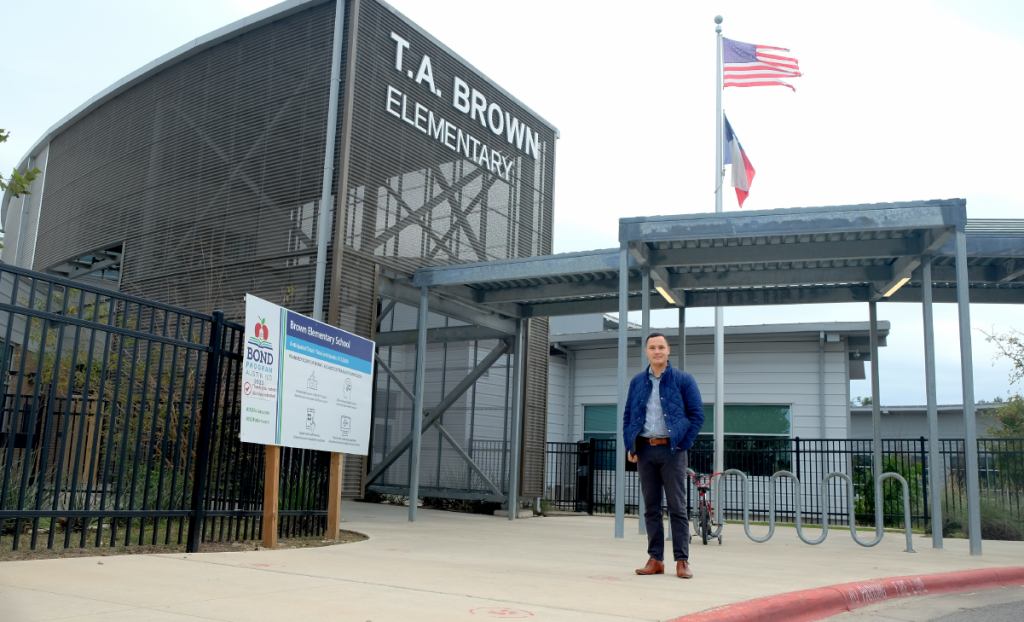
Andrew stands at the entrance of T.A. Brown.
Is there a book, documentary, or other piece of media you would recommend for folks wanting to learn more about these topics?
I encourage people to learn about the following:
- Bright Green Future Grants Program
- Austin Parks Foundation’s Community Impact Grants
- Austin’s Urban Forest Plan
What advice do you have for others?
Here are some of the big takeaways I’ve learned through the project management process:
- Research and Planning: Start with thorough research to understand the needs of your community and identify suitable projects. Careful planning is key to success.
- Community Involvement: Leverage private/public partnerships within your community, local organizations, and schools to gather support and volunteers. Collaboration strengthens your project’s impact.
- Grant Opportunities: Explore grant programs that align with your project’s goals and objectives. Tailor your grant application to clearly convey the positive impact your project will have.
- Education: If your project involves educational aspects, highlight how it will inspire and educate students or community members about environmental issues.
- Persistence: Be prepared for challenges and setbacks along the way. Persistence and dedication are essential for seeing your project through to completion.

Trees play an essential role in our fight against climate change. Planting season in Central Texas runs from October to March before it becomes too hot for trees to establish themselves. Adopt a tree, as Andrew did, from TreeFolks’ NeighborWoods program, or learn more about Austin’s urban forest ecosystem.
Share your Net-Zero contributions with us on Twitter or Facebook, and use #NetZeroHero. If you know a Net-Zero Hero (or heroes!) who should be recognized for their efforts, send your nomination to sustainability@austintexas.gov.
